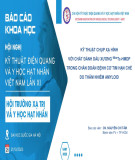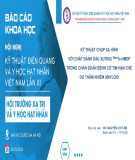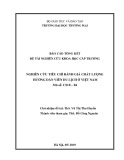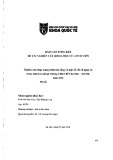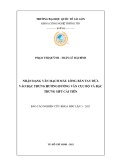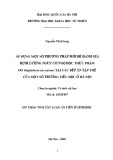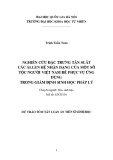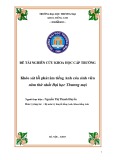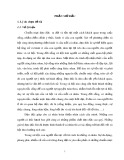
1
INTRODUCTION
There are six parts in the introduction. They are motivation for the study, aims
of the study, scope of the study, significance of the study, related previous studies and
organization of the study.
1. Motivation for the study
Today English is the language widely used in the world. English is not only the
national or official language of some countries, which have different cultures, but it is
also the international language of communication in many fields including science,
technology, business, entertainment and so on. Since Viet Nam joined World Trade
Organization (WTO), the need for learning English has been considerably increasing
among Vietnamese because their proficiency in English can help them get good jobs.
Therefore, learning English is very necessary.
However, it is not easy to master this language. In order to become good
English learners, besides proficiency in listening, speaking, reading and writing skills,
they must use grammar properly although English grammar can be difficult. Numerous
studies show that the use of poor grammar in spoken and written statements reflects
negatively on the speaker or author, and that people who use bad grammar are instantly
perceived as being less intelligent, less reliable or less trustworthy than people who use
proper grammar. Consequently, it is essential for English learners to master grammar.
English grammar includes a lot of points. One of them is reported speech.
Reported speech is important but rather difficult because it involves a lot of elements
which causes students to feel confused and make many errors. Making so many errors
of reported speech is not good because when someone reports incorrectly what
someone else has said, it is difficult for listeners to understand or it is even easy for
them to misunderstand, causing serious consequences. In addition, reported speech
often appears on tests in class, final tests and tests in the entrance exams to universities
and colleges. If students do not master this grammar point, they may lose marks
relating to reported speech easily. For those reasons, the researcher decided to study the
topic “Common Errors of Reported Speech Made by Grade 11 Students at Doc Binh
Kieu High School, Tien Giang Province”. This study is aimed at searching for the

2
grade 11 students‟ common errors and suggesting some solutions to help the students
use reported speech better.
2. Aims of the study
- To find out grade 11 students‟ common errors in using reported speech.
- To suggest some solutions to help the students avoid these errors.
3. Scope of the study
The study is about common errors of reported speech based on the exercise the
researcher gives grade 11 students at Doc Binh Kieu High School.
4. Significance of the study
The study including the solutions suggested will help students avoid common
errors of reported speech. Some solutions are suggested for teachers so that they can
apply to help the students in learning reported speech.
5. Related previous studies
Many theses relating to reported speech have been studied. The research
“Teaching Reported Speech” done by Dan Rej Regmi was about the major mistakes
made by the learners of Grade XII of Management stream. However, the researcher
only gave suggestions for teachers to teach their Nepalese students in order to help
them understand and use reported speech precisely.
In Vietnam, Le Thi Thu Quynh, student of Ho Chi Minh University of
Education did the research “Indirect speech in English and Vietnamese: A comparative
contrastive analysis” in 2010. In this research, the researcher has pointed out basic
similarities and differences in indirect speech between Vietnamese and English as well
as some major mistakes made by Vietmanese. However, the subjects were Vietnamese
learners in general and the researcher gave a general suggestion instead of specific ones
to help them avoid those errors. The suggestion was that Vietnamese people have to
pay more attention to grammar structure when they want to change an English indirect
speech into the direct one.

3
6. Organization of the study
INTRODUCTION
Chapter 1 LITERATURE REVIEW
1.1 Definition of reported speech
1.2 Types of reported speech
1.2.1 Reported statements
1.2.2 Reported imperatives
1.2.3 Reported questions
1.2.4 Reported exclamations
1.2.5 Mixed types of reported speech
13. Changes of direct speech when turned into reported speech
1.3.1 Pronoun changes
1.3.2 Adjective changes
1.3.3 Tense changes
1.3.4 Modal verb changes
1.3.5 Adverb changes
1.3.6 Exceptions
Chapter 2 METHODOLOGY
2.1 Research questions
2.2 Research participants
2.2.1 The researcher
2.2.2 The subjects
2.3 Data collection instruments
2.3.1 The questionnaire
2.3.2 The mini-test
2.4 Research procedure
2.4.1 The questionnaire
2.4.1 The mini-test

4
Chapter 3 RESULTS, DISCUSSIONS AND SUGGESTIONS
3.1 Results
3.1.1 Results collected from the questionnaire
3.1.2 Results collected from the mini-test
3.2 Discussions
3.2.1 The questionnaire
3.2.2 The mini-test
3.3 Suggestions
3.3.1 For the teachers
3.3.2 For the students
CONCLUSION AND LIMITATIONS
REFERENCES
APPENDIX 1
APPENDIX 2
APPENDIX 3

5
Chapter 1 LITERATURE REVIEW
In this chapter, the theory of reported speech is presented including definition of
reported speech, types of reported speech and changes of direct speech when turned
into reported speech.
1.1 Definition of reported speech
Reported speech or indirect speech refers to using a noun clause to report what
someone has said. No quotation marks are used. ( 3 )
Example:
Direct speech: She said, “She hasn‟t met Susan for two years.”
Reported speech: She said (that) she hadn‟t met Susan for two years.
1.2 Types of reported speech
1.2.1 Reported statements
Statements (“S + V”)
Reported speech
Examples:
Direct speech: “I‟m waiting for my mother,” he said.
Reported speech: He said that he was waiting for his mother.
Direct speech: Rick said to me, “Anne has written Jim a letter.”
Reported speech: Rick told me that Anne had written Jim a letter.
Direct speech: She hopes, “I will pass the exam.”
Reported speech: She hopes that she will pass the exam.
1.2.2 Reported imperatives
Affirmative imperatives (“V……”)
Reported speech
S + say / said /... + (that) + S + V
tell + O / told + O /…
think / thought /…
hope / hoped /…
…………….


